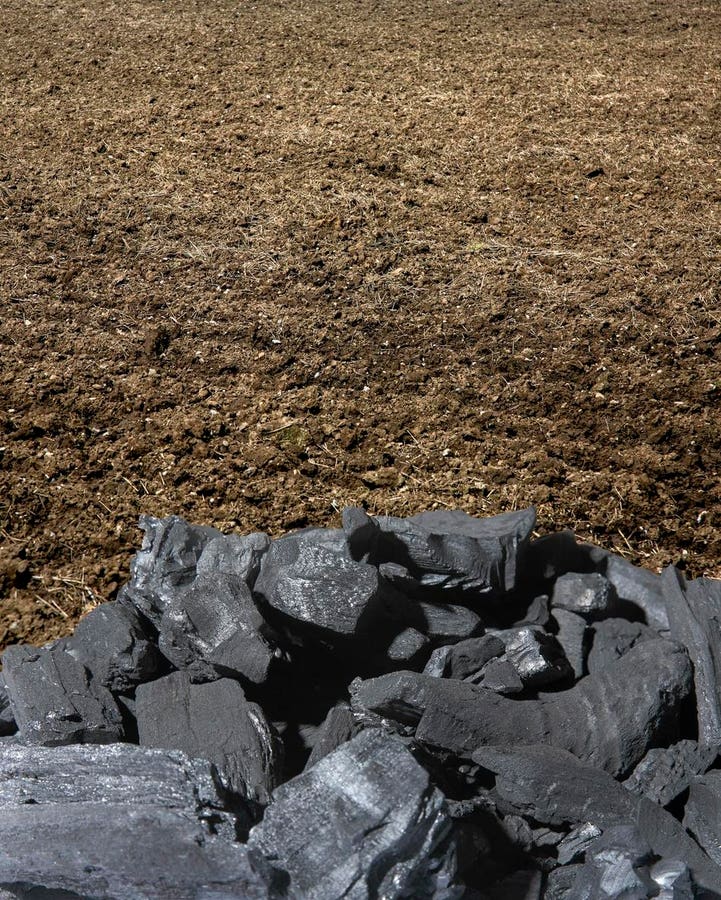Share to Facebook Share to Twitter Share to Linkedin Biochar is a form of charcoal (mostly carbon) produced by heating organic matter in the absence of … [+] oxygen, a process called pyrolysis. This avoids the production of carbon dioxide and locks up the carbon in the biochar. In this form, the carbon can remain in soils for thousands of years, increasing the soil fertility and acting as a carbon sink. This sequestration of the carbon helps to meet targets to reduce emission of carbon dioxide, a cause of climate change. getty In 2023, a US National Science Foundation-supported study from researchers at the University of Massachusetts found that the rate of soil erosion in the midwestern US was ten to 1,000 times greater than pre-agricultural erosion rates. A 2022 United Nations report estimated that up to 40 percent of all soils globally are moderately or severely degraded. If deforestation, overgrazing, intensive cultivation, urbanization, and other harmful practices continue, that number could rise to 90 percent by 2050. “Modern agriculture is unsustainable,” said Kathryn Radovan, Senior Vice President of Business Operations and Co-Founder of Terra Vera. “Our society is caught in a vicious cycle: food demand continues to outpace supply; farmers have no choice but to use toxic solutions to keep up with demand; overuse of these solutions leads to resistivity and yield decline; and ultimately, climate change worsens, which contributes to our ongoing public health crisis and biodiversity loss.” “Key contributors to climate change include chemical runoff, plastic waste, and CO2 emissions related to the production, shipment and usage of pesticides and fertilizers, which also harm our soils,” adds Radovan. Radovan says most of the agricultural products available on the markets for growers are made with ingredients meant to extend the shelf life of the chemicals. “You’re probably wondering why growers would choose synthetic and often toxic chemicals if they know they’re harmful to the environment, pollinators and unsafe for workers,” said Radovan. “There are biological approaches that are more eco-friendly, but unfortunately, those can be less effective and more expensive.” MORE FOR YOU New Galaxy S25 Ultra Exclusive Teases Samsung’s Ambitious Plans Janet Jackson Dismisses ‘Unauthorized’ Apology After Saying Kamala Harris Is Not Black—Here’s What To Know UFC 308 Loses One Of Its Best Main Card Fights Radovan says that while growers might want to use more sustainable solutions, this is not always economically feasible. TerraVera specializes in biomimicry solutions and delivering amino-acid-based nutrients without harmful chemicals and synthetic fertilizers for protected crops. Biochar Thor Kallestad, CEO and co-founder of Myno Carbon, a Washington state-based company that makes carbon-negative biochar materials, says the main reason our soils are degraded is that we have stripped them of carbon and pumped them with chemical fertilizers. “There’s a renewed recognition in the agricultural sector that soil health = plant health = business health, and biochar is a key part of the arsenal,” said Kallestad. “Biochar is a pure and stable form of carbon—it can last for hundreds of thousands of years—so by adding it to the soil, biochar can directly address soil degradation while benefiting soil health by increasing nutrient and water retention and repairing the soil microbiome.” “We see biochar as absolutely critical to reversing soil degradation,” said Kallestad. Reducing barriers Kallestad says that, as with many products that aren’t made with fossil-derived carbon, it comes down to incentives and scale. “Climate-smart products such as biochar are simply better products, full stop, but they have to compete against centuries of policy, industrial infrastructure and standardized practices of fossil-derived products.” “In addition, the lack of a mature and transparent carbon pricing market and sufficient buyers is a significant barrier to scale the biochar industry, even when biochar suppliers are leading the carbon removal market deliveries to buyers,” said Kallestad. Kallestad believes that if there were a standardized price on carbon pollution, biochar and other carbon-negative products, they would quickly expand market share throughout the economy at the expense of products derived from fossil carbon. “We just need to level the playing field, not get special advantages,” he added. Biochar early adopters Biochar is best known as an effective soil amendment for home gardening. “There are many proven uses beyond soil amendment for home gardening that are at much bigger scales,” said Kallestad. “Biochar can be used as an amendment in industrial agriculture to improve the Nutrient Use Efficiency (NUE) of both organic fertilizers like compost and humic acid and common synthetics like urea or potassium sulfate—and reduce irrigation water usage at the same time.” The built world “The built environment is another big opportunity—we’re all familiar with the insane stats about how much cement we’re going to produce in the coming decades and the massive carbon footprint of the cement industry,” said Kallestad. Forty percent of global greenhouse gas emissions come from buildings, and if left unchecked or remediated, reports indicate that the number will double in 25 years by 2050. “We’ve done some initial trials that show that our biochar improves cement strength while permanently sequestering carbon for thousands of years,” said Kallestad. “We’re expecting that to be a big market going forward.” Environmental remediation “Environmental remediation is also becoming more urgent, and, ironically, currently relies heavily on coal-based activated carbon,” said Kallestad. “Study on study shows that biochar is more effective dollar for dollar on removing emerging contaminants such as PFAS, but scalability has slowed adoption,” added Kallestad. Ten years ago, in 2014, the Yale School for the Environment published a study that showed that biochar made from plant fodder and/or even chicken manure could be used to remove mercury from power plant emissions and clean polluted soil. The report noted that the big question was whether biochar could be produced on a large scale to slow or reverse global warming. “Environmental remediation, because competing products like activated carbons are very expensive, and biochar is essentially on par as a fit-for-purpose replacement material,” said Kallestad. “Liquid fertilizers are another market in which early adopters will incorporate biochar.” Kallestad says liquid form allows direct conveyance to the root system, where the biochar delivers the most significant benefits. This, he believes, increases biochar’s value proposition. The next five years “We’re in the midst of building a new infrastructure: a network of Carbon Removal Facilities (CRFs), essentially facilities that will produce tens of thousands of tons of biochar each—and in the process permanently remove five million tons of CO2 each year,” said Kallestad. He believes this will solve the scale problem that the biochar industry has faced and will catalyze biochar adoption in key markets by providing a dependable supply at a better price than has been possible before. “The biochar market is already growing fast—and most analytics firms are forecasting ~15% CAGR over the coming decade,” said Kallestad. “That’s a great reason to be bullish on biochar in the near-term, though clearly it will vary across sectors.” Kallestad says that in the next five years, the uptake might be slower in some sectors like pharmaceuticals. “But we hope but to hit tipping points in other industries as scale brings costs down, new climate and environmental regulations come into play, and our scientific studies confirm biochar’s efficacy in emerging areas of environmental remediation, for example.” Kallestad adds that with a robust market pull, US biochar production has the potential to remove over a billion metric tonnes of CO2e per year and avoid another five billion. “This is all the while accelerating drawdown in agriculture and other sectors, that’s absolutely immense,” he said. “As a climate solution, biochar is far from the most technologically complex—but it’s the one with the most co-benefits beyond climate,” said Kallestad. “For every pound of biochar produced, two pounds of CO2 are removed from the atmosphere. That’s impact right there.” Follow me on Twitter or LinkedIn. Check out my website. Jennifer Kite-Powell Following Editorial Standards Forbes Accolades
Subscribe
Login
0 Comments





